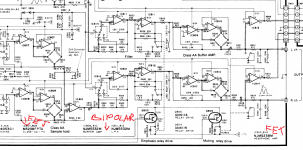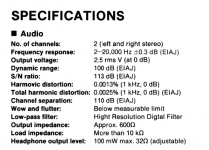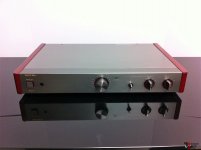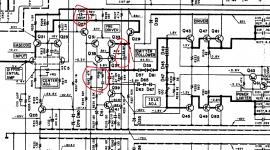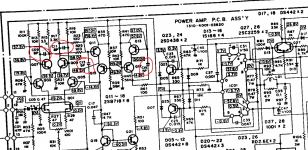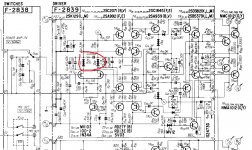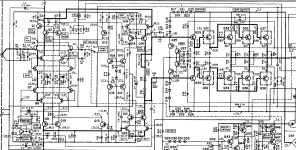"Also, as a reply to dreamth regarding the Common Mode Rejection Ratio (CMRR) and Power Supply Rejection Ratio (PSRR) – just increasing gain is not the silver bullet.
Careful, proper layout and accurately balanced amp loading is key. Maintaining a super high CMRR and PSRR is a bit like balancing a needle vertically on a table. Or put in another way, it is all too easy to make a great spec amp perform like a humble [FONT=FreeSans, sans-serif]µ[/FONT]A741 – and the same goes for audio power amp stages."
It may not be the answer in madical equipment with their > 1gigaohm input impedancesand fantastically faint signal down to DC, but i can't see many audio applications where that doesn't work...Audio field is always a balance between the musical content its distortions and noise on one hand and PSRR and CMRR on the other hand and all accordingly to human ear ability to hear them.The one that's higher wins the jackpot! Although i saw lots of balanced designs i could hardly see or hear any benefit in having double component count except in mixing recording or touring consoles if they don't have input transformers...Other than that balanced operation makes most things unnecessarily complicated for the outcome.You can live with losing 3db SNR for better PSRR and CMRR if your wiring is very long but other than that at line level is completely unnecessary.
Careful, proper layout and accurately balanced amp loading is key. Maintaining a super high CMRR and PSRR is a bit like balancing a needle vertically on a table. Or put in another way, it is all too easy to make a great spec amp perform like a humble [FONT=FreeSans, sans-serif]µ[/FONT]A741 – and the same goes for audio power amp stages."
It may not be the answer in madical equipment with their > 1gigaohm input impedancesand fantastically faint signal down to DC, but i can't see many audio applications where that doesn't work...Audio field is always a balance between the musical content its distortions and noise on one hand and PSRR and CMRR on the other hand and all accordingly to human ear ability to hear them.The one that's higher wins the jackpot! Although i saw lots of balanced designs i could hardly see or hear any benefit in having double component count except in mixing recording or touring consoles if they don't have input transformers...Other than that balanced operation makes most things unnecessarily complicated for the outcome.You can live with losing 3db SNR for better PSRR and CMRR if your wiring is very long but other than that at line level is completely unnecessary.
Last edited:
Before doubling any transistor you may try splitting the emitter resistors and connect them to output as both simulations and some good authors recomend that too for lower distortions:
Firstly, as a general point. I think that ginetto asks some quite reasonable polite questions and he deserves polite, non-condescending answers to these.
Moving on, I think the jury is out on whether or when it is desirable to split the driver emitter resistors. I know that there are different views on this, but AFAIK all Rotel output stages use an emitter follower topology which allows the drivers to actively and quickly cut-off and de-charge the output transistors by reverse biasing them when asked to do so.
If you split the emitter resistors to the output node you will reduce that active ability significantly and actually increase crossover distortion?
But, I haven't tried it out and have no real life measurements to confirm either yes or no.
Doubling the output transistors is an interesting point. I can see some physical problems to do so in the crammed RA-800/900 series with their small heat sinks. I suppose that you could piggyback another set on top of the existing, but I haven't tried that.
The old SANYO 2SD1047 and 2SB817 do seem to get tired with age. Their hFE drops quite a bit, the NPN's more than the PNP's. And they are already long discontinued devices.
So whenever I have an amp with one or more blown Sanyo's I replace all with NJW0302 / NJW0281 which works great.
I have also tried Sanken types (can't think of the type numbers off my head). I believe the Sankens are actually internally paralleled devices on one die (?) which could be an easier and better way of multiplying output transistors.
Any which way, they all sound great with no measurable and very little audible difference between them.
Best,
Per
I don't see where i was disrespectfull to ginetto61, and actually if i didn't mentioned him then it was adressed to you...
I was hinting at doubling the drivers to be able to drive the be junction capacitance of the final stage easier, not the final stage as that is already doubled.
All the simulations i made with split resistors were better and Arto Kolinummi measured that too with the same results .Not paralleling the BE junction capacitance with a resistor isn't going to make any favor to the driver...
I was hinting at doubling the drivers to be able to drive the be junction capacitance of the final stage easier, not the final stage as that is already doubled.
All the simulations i made with split resistors were better and Arto Kolinummi measured that too with the same results .Not paralleling the BE junction capacitance with a resistor isn't going to make any favor to the driver...
I would like just ask you if there is a specific post with all the mods performed not in details but just to see which part of the design you have tackled with.
It looks like the technical discussion on the ra-820ax ends around page 13 ?
personally i think that this nice little amp modding project would deserve a thread by itself. But it is just my humble opinion 😱
For the 50 Hz noise i would try to take the mains transformer out of the enclosure. It makes thing surely more complex ... but could pay dividend.
Thank you very much again.
Kindest regards, gino
Hi gino,
The RA-820AX is definitely a very nice little amp. It clearly has a few design flaws and now suffers from ageing components, but it can indeed be upgraded to an audiophile standard that you (and others) will find hard to believe. I have one dusty specimen standing on the floor patiently awaiting its turn on the workbench (five RA-931's and two NAD3030's before it in the queue).
Things have indeed moved on and made simpler since page 13 of this thread and I will readily share the upgrade techniques as and when. You will just have to be as patient as the 820 on my floor.
Now to your balance and volume pot questions. In the 820 these are 100k and 50k nice quality ALPS pots. Ok, these high values could sound as potential resistor noise mayhem at their signal input position, but in normal use the issue is actually much less alarming. Each wiper track of the balance pot has one half silver track (low ohms) and the other half the 100k carbon track. So, when put in the center position, there is actually very little resistance – or noise coming from it.
The volume pot is logarithmic, which means that in most "normal" listening positions (say, 8-10 o'clock) it also has a relatively modest effective resistance and hence, noise. If you turn it up above high noon, your speakers and your ears will start to supply oodles of more distortion.
The total noise in an opamp preamp is: Vn(total) = [FONT=FreeSans, sans-serif]SQRT[/FONT] [(in*Rs)2 + (en)2 +4kTRs]
Rs is the source resistance, in the input current noise and en the amp’s voltage noise.
So when you put in a FET input opamp like OPA2134 with input currents in the pA range through these “moderate” pot source resistances, it basically comes down to the voltage noise en which is definitely not half bad in the OPA2134 at 1.2 [FONT=FreeSans, sans-serif]µ[/FONT]Vrms. And to boot it also has a low laser trimmed output offset which allows you to direct couple the preamp to the power stage, eliminating any electrolytic capacitors in the signal chain without getting overall amp output offsets.
Ok, there is obviously more to this topic than mentioned here, but for all practical matters IMHO there is very little extra to vastly (or easily) improve upon in this preamp stage. Just leave it in.
Unless of course if you decide to bin the entire amp and go out and spend £1000’s on a heavily up-waffled beast

I don't see where i was disrespectfull to ginetto61, and actually if i didn't mentioned him then it was adressed to you...
I was hinting at doubling the drivers to be able to drive the be junction capacitance of the final stage easier, not the final stage as that is already doubled.
All the simulations i made with split resistors were better and Arto Kolinummi measured that too with the same results .Not paralleling the BE junction capacitance with a resistor isn't going to make any favor to the driver...
Ok, I may have overreacted, sorry.
Best
Per
He may change the pots to 10k if he finds suitable ones and go with njm2043 which as low noise as one can expect cheap and very good.Hi gino,
Now to your balance and volume pot questions. In the 820 these are 100k and 50k nice quality ALPS pots. Ok, these high values could sound as potential resistor noise mayhem at their signal input position, but in normal use the issue is actually much less alarming.
So when you put in a FET input opamp like OPA2134 with input currents in the pA range through these “moderate” pot source resistances, it basically comes down to the voltage noise en which is definitely not half bad in the OPA2134 at 1.2 [FONT=FreeSans, sans-serif]µ[/FONT]Vrms.
He might study a bit this schematic as to see that inverting configuration with bipolar op-amps isn't necessarily noisy either...as this was one of the best cd player ever made and still outperforms tons of modern digital audio.
As he likes to tinker he might find suitable a 10k log-antilog potentiometer in an op-amp feedback loop and he can lower the input in a smarter way with inverting topology, thus being able to handle high input signals with lower distortions.
Attachments
Last edited:
Hi gino, The RA-820AX is definitely a very nice little amp. It clearly has a few design flaws and now suffers from ageing components, but it can indeed be upgraded to an audiophile standard that you (and others) will find hard to believe.
Hi ! my interest in your excellent thread has been driven exactly by the feeling that a lot can be done to improve its performance. And it is perfectly reasonable. We are talking about a very low price unit ... design aside the parts cannot be top quality ... mains transformer and supply caps in particular. I am pretty sure that even just changing them will provide benefits to the sound.
I will be waiting ... i am always here around. I understand there are other models maybe more requested ... lately my interest for little power amps has increased because i have decided to switch to high efficiency speakers ... 20-30 robust watts per channel should be more than enoughI have one dusty specimen standing on the floor patiently awaiting its turn on the workbench (five RA-931's and two NAD3030's before it in the queue). Things have indeed moved on and made simpler since page 13 of this thread and I will readily share the upgrade techniques as and when. You will just have to be as patient as the 820 on my floor.
So the focus is more on the sound quality than power delivery ... also because often i have read that simpler circuits have a bigger potential for better sound ... if this is really true i do not know of course
Now to your balance and volume pot questions. In the 820 these are 100k and 50k nice quality ALPS pots. Ok, these high values could sound as potential resistor noise mayhem at their signal input position, but in normal use the issue is actually much less alarming. Each wiper track of the balance pot has one half silver track (low ohms) and the other half the 100k carbon track. So, when put in the center position, there is actually very little resistance – or noise coming from it.
The volume pot is logarithmic, which means that in most "normal" listening positions (say, 8-10 o'clock) it also has a relatively modest effective resistance and hence, noise. If you turn it up above high noon, your speakers and your ears will start to supply oodles of more distortion.
The total noise in an opamp preamp is: Vn(total) = [FONT=FreeSans, sans-serif]SQRT[/FONT] [(in*Rs)2 + (en)2 +4kTRs]
Rs is the source resistance, in the input current noise and en the amp’s voltage noise.
So when you put in a FET input opamp like OPA2134 with input currents in the pA range through these “moderate” pot source resistances, it basically comes down to the voltage noise en which is definitely not half bad in the OPA2134 at 1.2 [FONT=FreeSans, sans-serif]µ[/FONT]Vrms.
And to boot it also has a low laser trimmed output offset which allows you to direct couple the preamp to the power stage, eliminating any electrolytic capacitors in the signal chain without getting overall amp output offsets.
This is great. I think i have understood. But .... who really plays these days with the balance and even more with the tone controls ? the lunatics ?
And actually if you look up in the Rotel catalogue (i am attaching a pic of the old TOTL Michi preamp) you will see that they are gone with the wind ...
Why not pruning a little ... the loudness era is ended.
Then my other question was ... is the op-amp in front of the power amp stage really needed ? why not connecting the pot (maybe changing its value) directly to the power amp stage ? If i am not wrong this is done in the ra-935bx model
https://www.vintageshifi.com/repertoire-pdf/pdf/telecharge.php?pdf=Rotel-RA-935BX-Service-Manual.pdf
I remember this amp getting a best buy from HiFi Choice magazine ?
I like the idea of pruning out what is not really needed ... i have replaced with jumpers the balance control on a preamp (with no tone controls) and i have had not the least regret. I had this feeling that it was messing the sound ?
I think we all want to hear what is in the recording ... nothing less nothing more. Just what is there. In the good and in the bad ... the utmost transparency.
of course not. I like the modding approach a lot. It is just reasonable that good commercial units can be upgraded with the right mods.Ok, there is obviously more to this topic than mentioned here, but for all practical matters IMHO there is very little extra to vastly (or easily) improve upon in this preamp stage. Just leave it in.
Unless of course if you decide to bin the entire amp and go out and spend £1000’s on a heavily up-waffled beast
And actually your creations show this very clearly and congratulations again. The idea of taking something already basically good and raise its sound quality is very fascinating.
These cheap but very good units are always the result of commercial compromise ... some high grade parts are very very expensive. Like high quality mains transformer ... high grade supply caps ... and volume pots of course.
Thanks a lot again.
Kind regards, gino 🙂
Attachments
Last edited:
This is great. I think i have understood. But .... who really plays these days with the balance and even more with the tone controls ? the lunatics ?
Fair point, but not every lunatic lives in a spacious mansion with a perfect listening position. And if you are directed by the Wife Acceptance Factor (WAF) to remove the speakers to the corners of the room, you may be tempted to fiddle with soundstage balance and/or reduce the bass speaker output.
But hey, of course not me, I live in a perfect house with a perfect wife and I will always stand in the perfect listening position whenever she speaks
Anyway, I have indeed been asked to modify Rotels to completely bypass these circuits because all the volume control was done in a remote controlled DAC - and it is very straightforward to do. I can show you how if you want.
Best
Per
Fair point, but not every lunatic lives in a spacious mansion with a perfect listening position. And if you are directed by the Wife Acceptance Factor (WAF) to remove the speakers to the corners of the room, you may be tempted to fiddle with soundstage balance and/or reduce the bass speaker output.
But hey, of course not me, I live in a perfect house with a perfect wife and I will always stand in the perfect listening position whenever she speaks

Anyway, I have indeed been asked to modify Rotels to completely bypass these circuits because all the volume control was done in a remote controlled DAC - and it is very straightforward to do. I can show you how if you want.
Best
Per
This is great. I think i have understood. But .... who really plays these days with the balance and even more with the tone controls ? the lunatics ?
Fair point, but not every lunatic lives in a spacious mansion with a perfect listening position.
And if you are directed by the Wife Acceptance Factor (WAF) to remove the speakers to the corners of the room, you may be tempted to fiddle with soundstage balance and/or reduce the bass speaker output.
Hi thanks again and sorry i did not want to sound unrespectful of wives desiderata
 However being single i do not have WAF issues ... but very critical NAF issues ... Neighbours Acceptance Factors 🙁🙁🙁
However being single i do not have WAF issues ... but very critical NAF issues ... Neighbours Acceptance Factors 🙁🙁🙁I cannot raise the volume as high as i like ... for now at least
If you say the tone controls are needed to save marriages i trust you and i understand.
Maybe a bypassing switch for when the wife is out shopping would be nice to have 😀
this is an interesting option but i heard that controlling the volume digitally could reduce the resolution ? i do not know for sure but some prefers to attenuate the level in the analog domain.But hey, of course not me, I live in a perfect house with a perfect wife and I will always stand in the perfect listening position whenever she speaks
Anyway, I have indeed been asked to modify Rotels to completely bypass these circuits because all the volume control was done in a remote controlled DAC - and it is very straightforward to do. I can show you how if you want.
Best Per
I can remember one review about a pre plus power combination (mid priced) by Rotel. The panel heard a nice improvement swapping the Rotel pre (i do not remember the model but i am pretty sure was op-amp based) for a tube line preamp. And they ended to praise the power amp much more than the preamp. This and others reports made me think about line preamps.
Tube preamps forte is the midrange. The voices are very nice with tubes.
And also the 3D effect is very nice indeed.
I also have the feeling that the attenuator quality impacts a lot on the overall sound.
I understand that many integrates are just a high quality pot followed by a power stage ? and they are said to sound fine ? so maybe that is the way.
Today i am looking more to buffers than line stages with gain. And use more of the gain provided by the power amp.
Another naive decision could be to take the mains transformer out of the enclosure and use an umbilical. In this way the transfer of any vibration from it to the board would be avoided. Some manufacturers used to do this.
Maybe it pays dividen ? 🙄
Last edited:
There's no purely analogue domain..that is just some grey haired people favorite illusion. There's a reason for why music scale hase some clear notes and intervals as well as any audio amplifier has an input LOGARITHMIC potentiometer.
All nature is defined by discrete levels of energy with no continuous level scale in between.If there was a continuous energy level alteration scale anywhere in the universe you couldn't punch anyone in his face cause you'd simply pass through him, we'd be invisible, immortal and indestructible.
Try a linear potentiometer in front of your amplifier if you don't believe it.By the way...the best phono theory analyses you can find are done by this guy which is rarely talked of here on diyaudio and i can only think that's out of pure envy because he's simply the best :
Website of Wayne Stegall - Analog is Digital
All nature is defined by discrete levels of energy with no continuous level scale in between.If there was a continuous energy level alteration scale anywhere in the universe you couldn't punch anyone in his face cause you'd simply pass through him, we'd be invisible, immortal and indestructible.
Try a linear potentiometer in front of your amplifier if you don't believe it.By the way...the best phono theory analyses you can find are done by this guy which is rarely talked of here on diyaudio and i can only think that's out of pure envy because he's simply the best :
Website of Wayne Stegall - Analog is Digital
Jumping in here very late. Just saw the thread and I admire the old 800 series amps.
I went through a long orocess finding amps I like and my wife woudl accept when I was playing big-band. Afgter much research I found many of the critical "drivers"
Went through Sanyo MOSVET, CK, Haflers, B&K, Rotels, and finally Parasound before I built my own.
Self shows us how to build a very great readig amp. A bit flat soundig. Too much feedback our frend Mr. Pass wil say.
Again Mr. Pass has shown us how to build stages that need little feedback.
Using many more outputs to keep their current down. OK, all SOP.
Here is the last key that John Curl led me to and it was the "veil" that lifted off the music ( I did this on a Rotel). It is the method of compensation in the second stage. Rotel, KNOWING they are top of mid/entry high end assumed use on a more commodity speaker. Their use of dominant pole filter for compensation helps keep away from tweeter breakup as HD decreases with frequency. But with really good tweeters, going to Transient Miller really opens up the amp. I was successful in a Rotel, and then built my own MOSFET using TMC. Not easy by the way, as they tend to turn into ultrasonic oscillators and go poof.
So, I commend Rotel on designing for their market. They knew what they were doing and why. I also now appreciate why the Parasound 1200 is the best sounding amp I have ever heard, well, I am biased for mine. So, one can do standard POOGE. Component quality, better CCS, etc. But the change in second stage is huge, but only if you are running $50 or better tweeters!
Yea, energy is quantum. Not really relevant to the resolution in audio. We grey hair guys know the difference between empirical theory and applied engineering. I would argue in the applied domain, digital is theory only as application involves slew rate.
I went through a long orocess finding amps I like and my wife woudl accept when I was playing big-band. Afgter much research I found many of the critical "drivers"
Went through Sanyo MOSVET, CK, Haflers, B&K, Rotels, and finally Parasound before I built my own.
Self shows us how to build a very great readig amp. A bit flat soundig. Too much feedback our frend Mr. Pass wil say.
Again Mr. Pass has shown us how to build stages that need little feedback.
Using many more outputs to keep their current down. OK, all SOP.
Here is the last key that John Curl led me to and it was the "veil" that lifted off the music ( I did this on a Rotel). It is the method of compensation in the second stage. Rotel, KNOWING they are top of mid/entry high end assumed use on a more commodity speaker. Their use of dominant pole filter for compensation helps keep away from tweeter breakup as HD decreases with frequency. But with really good tweeters, going to Transient Miller really opens up the amp. I was successful in a Rotel, and then built my own MOSFET using TMC. Not easy by the way, as they tend to turn into ultrasonic oscillators and go poof.
So, I commend Rotel on designing for their market. They knew what they were doing and why. I also now appreciate why the Parasound 1200 is the best sounding amp I have ever heard, well, I am biased for mine. So, one can do standard POOGE. Component quality, better CCS, etc. But the change in second stage is huge, but only if you are running $50 or better tweeters!
Yea, energy is quantum. Not really relevant to the resolution in audio. We grey hair guys know the difference between empirical theory and applied engineering. I would argue in the applied domain, digital is theory only as application involves slew rate.
You're talking as if Parasound invented the VAS miller compensation...besides being used since the first transistors were used in electronic equipment there were even cascode compensated vas stages before parasound even took off...Every time i hear people mention some well known 5 "audiophile" manufacturers that filled some audio magazine pages at some point then settling for one as absolute experience i start craving in my bed in pain 🙂
Parasound's borbely -lender like vas works because of the input fet stage currents , otherwise its compensation would be completely useless as there wouldn't be any speed to slow down at all with a cascode high Z output driving a low z emitter. So basically parasound taught us how to use expensive fet input transistors to be able to drive a lender vas in pain... https://www.diyaudio.com/forums/solid-state/229419-ltp-vas-interconnection.html#post3358106
I think that most people who try Lender would better first realize why its first implementation was done as it was in the first place:
The most linear stage for large voltage swings - Lender's Circuit
http://www.davidsaudio.com/assets/images/autogen/a_ampzilla_sch.jpg
Parasound's borbely -lender like vas works because of the input fet stage currents , otherwise its compensation would be completely useless as there wouldn't be any speed to slow down at all with a cascode high Z output driving a low z emitter. So basically parasound taught us how to use expensive fet input transistors to be able to drive a lender vas in pain... https://www.diyaudio.com/forums/solid-state/229419-ltp-vas-interconnection.html#post3358106
I think that most people who try Lender would better first realize why its first implementation was done as it was in the first place:
The most linear stage for large voltage swings - Lender's Circuit
http://www.davidsaudio.com/assets/images/autogen/a_ampzilla_sch.jpg
Attachments
Last edited:
Not at all. John only invented the floating JFET bias on the input, but he led me to the different way the feedback works and the effect on the sound. This let me understand why Rotel chose the architecture they did and why He chose the one he did. They both made smart decisions based on their market.
"Not at all. John only invented the floating JFET bias on the input,"
Are you sure about it?
https://www.google.com/url?sa=t&rct=j&q=&esrc=s&source=web&cd=&ved=2ahUKEwjPwufDt6_rAhXEGuwKHQWsC5IQFjABegQIBRAB&url=https%3A%2F%2Fpatentimages.storage.googleapis.com%2Fpdfs%2FUS3302039.pdf&usg=AOvVaw27JtSdSxu7Ub5LeTQriaFW
At that time bjt transistors were often simbolized the same with the j-fet transistors...
Are you sure about it?
https://www.google.com/url?sa=t&rct=j&q=&esrc=s&source=web&cd=&ved=2ahUKEwjPwufDt6_rAhXEGuwKHQWsC5IQFjABegQIBRAB&url=https%3A%2F%2Fpatentimages.storage.googleapis.com%2Fpdfs%2FUS3302039.pdf&usg=AOvVaw27JtSdSxu7Ub5LeTQriaFW
At that time bjt transistors were often simbolized the same with the j-fet transistors...
Even if he is truthfull it's meaningless.Having 4 matched p-n channel input fets is a really difficult and expensive choice .There was a better and cheaper choice which was developped and refined by two other companies in the late 70's to early 80's..Both amplifiers are superior to the best parasound amplifier ever launched on the market.
Attachments
Last edited:
So what - he concludes that inside the audio band quantum noise is buried in white noise. That is correct and nothing surprising at all.There's no purely analogue domain..that is just some grey haired people favorite illusion. There's a reason for why music scale hase some clear notes and intervals as well as any audio amplifier has an input LOGARITHMIC potentiometer.
All nature is defined by discrete levels of energy with no continuous level scale in between.If there was a continuous energy level alteration scale anywhere in the universe you couldn't punch anyone in his face cause you'd simply pass through him, we'd be invisible, immortal and indestructible.
Try a linear potentiometer in front of your amplifier if you don't believe it.By the way...the best phono theory analyses you can find are done by this guy which is rarely talked of here on diyaudio and i can only think that's out of pure envy because he's simply the best :
Website of Wayne Stegall - Analog is Digital
And Dolby C or S wouldn't work on tape's noise either while DBX would be considered a better reducing sistem than Dolby 🙂
Guys,
This is an interesting discussion, but it does not belong on this Rotel improvement thread.
Could I perhaps please ask you to start a new thread for these non-analog quantum noise topics? My eyes are not as good as they once were, and I can no longer count these quantum particles.😉
Best,
Per. (A Grey Haired Illusionist)
This is an interesting discussion, but it does not belong on this Rotel improvement thread.
Could I perhaps please ask you to start a new thread for these non-analog quantum noise topics? My eyes are not as good as they once were, and I can no longer count these quantum particles.😉
Best,
Per. (A Grey Haired Illusionist)
- Home
- Amplifiers
- Solid State
- Improve a Rotel amp THD by 20dB!
